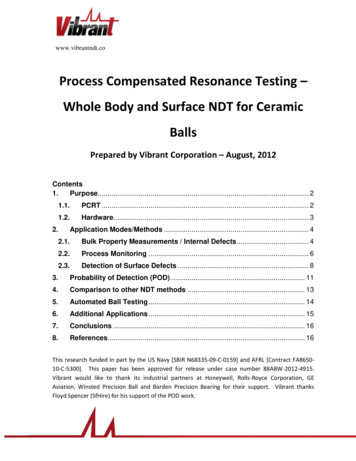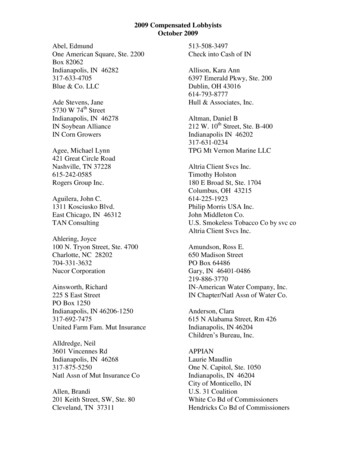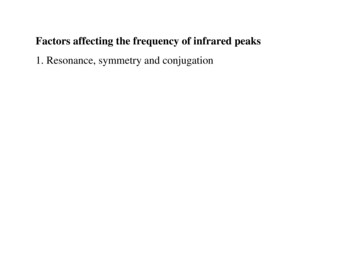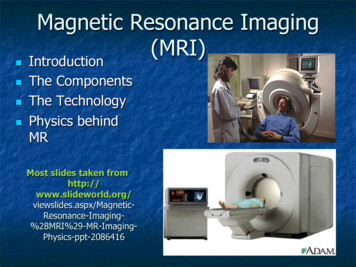
Transcription
www.vibrantndt.coProcess Compensated Resonance Testing –Whole Body and Surface NDT for CeramicBallsPrepared by Vibrant Corporation – August, 2012Contents1.Purpose. 21.1.PCRT . 21.2.Hardware. 32.Application Modes/Methods . 42.1.Bulk Property Measurements / Internal Defects . 42.2.Process Monitoring . 62.3.Detection of Surface Defects . 83.Probability of Detection (POD) . 114.Comparison to other NDT methods . 135.Automated Ball Testing . 146.Additional Applications . 157.Conclusions . 168.References. 16This research funded in part by the US Navy [SBIR N68335-09-C-0159] and AFRL [Contract FA865010-C-5300]. This paper has been approved for release under case number 88ABW-2012-4915.Vibrant would like to thank its industrial partners at Honeywell, Rolls-Royce Corporation, GEAviation, Winsted Precision Ball and Barden Precision Bearing for their support. Vibrant thanksFloyd Spencer (SfHire) for his support of the POD work.
www.vibrant.com1. PurposeHybrid bearings, using silicon nitride ceramic rolling elements, are a critical technology for futurehigh-performance gas turbine engine applications. While they offer significant performancebenefits over conventional steel balls, ceramic balls with critical defects suffer from high rates ofinfant mortality leading to catastrophic failure. Ceramic balls rely on nondestructive evaluationto certify them for use, but legacy inspection methods do not offer the accuracy, highthroughput and affordability required for widespread hybrid bearing application.Process Compensated Resonance Testing (PCRT) is a nondestructive evaluation method forceramic balls. PCRT uses measured resonant frequencies of parts to detect surface and internalflaws. For ceramic balls, internal defects and bulk material property variations are detected bymeasuring shifts of resonant peaks to lower or higher frequencies. Surface defects are detectedby measuring degeneracy in surface acoustic waves. A PCRT inspection detects both internaland external defects in a single sweep, and returns an automated pass/fail result.1.1. PCRTThe connection between material vibrations and material properties is based on thefundamental physical observation that the resonance responses of an object are related to itsstiffness and mass: (1)where f represents frequency, k is stiffness, and m is mass. Most resonance NDE methods focusmainly on the basic characteristics of the response, such as the frequency and amplitude. PCRTuses additional information provided by highly capable hardware and proprietary analysisalgorithms.Vibrant’s PCRT system makes extremely repeatable frequency measurements, which contributeto detection of much smaller variances than other resonance inspection systems. Repeatmeasurements for a given component are generally within 0.02 percent (standard deviation).The quantitative results provided by the PCRT sorting system can be used for suppliercomparison, process control feedback, and sliding scale acceptance criteria for applications withvarying degrees of criticality.PCRT uses genetic pattern recognition algorithms and resonant ultrasound spectroscopy (RUS)modeling software developed at Los Alamos National Labs (LANL) by Dr. Albert Migliori and theLANL resonant ultrasound group 8. PCRT proprietary software algorithms compensate fornormal manufacturing variations to permit focused detection of material alterations, processdeviations, raw material inputs, defects and service-related deterioration.Page 2 of 16
www.vibrant.comPCRT methods can be applied to silicon nitride spherical bearing elements, e.g. SiN balls, for avariety of outputs. PCRT measurements can be used to determine elastic material properties,such as Young’s modulus. They can also be used for process control monitoring, evaluation ofsupplier consistency, and detection of surface defects.Low-frequency resonance modes, mainly influenced by the bulk properties of the ball, identifydifferences in the material properties due to raw material supply and manufacturing conditions.Measurement of only the first few modes of the resonating sphere can identify even smallchanges in material properties such as density or Young’s modulus ( /- 1 percent or less). UsingVibrant RUS modeling capabilities, the Young’s modulus, Poisson’s ratio, and individual elasticmoduli (C11 through C66) of a ball can be quickly determined.Higher frequency resonance responses in SiN balls, correlating to surface acoustical waves(SAWs), and other modes restricted to the outer shell of the ball, are influenced by surfacedamage, and can be used to detect surface cracks and other flaws. Hardware developed atVibrant specifically for generating and detecting SAWs on SiN bearing surfaces extended PCRTcapabilities for detection of flaws generated in commercial manufacturing processes, andartificially induced surface defects.1.2. HardwareThe PCRT system consists of a transceiver, two or three transducers in a part fixture, and controlsoftware. A fixture developed for hybrid bearings is shown in Figure 1. The transceiver is aspecialized combination of a waveform generator that drives resonance in the part sample andan oscilloscope that measures the part response.Figure 1 – PCRT fixture for hybrid bearings (left). PCRT transceiver (right).The transducer is a custom piezo-electric device optimized for resonance testing across a widefrequency range. The tip of the transducer is silicon carbide, designed to be wear-resistant andPage 3 of 16
www.vibrant.comto present a common contact surface to the parts to be tested over a high volume of productiontests. The functional element is lead zirconate titanate (PZT), a material that expands when avoltage is applied, and produces a voltage when compressed. The deflection at the tip of thetransducer is very small, on the order of tens of nanometers. The resulting deflection of the testpart is also very small, measureable only with laser devices.Figure 2 – Functional schematic of a PCRT system.The transducer design has a lifetime of at least a million cycles, i.e. part tests, must remain dry,and cannot withstand significant shear loads. The transducer is a low-voltage device, and is nota safety concern. PCRT systems are compatible with the environment that eddy currentinspection machines for steel balls typically operate in.2. Application Modes/MethodsPCRT methods are unique among other NDT options in that they allow a quick inspection ofboth the bulk properties and the surface quality of the ball, without special sample preparation,excessive scanning, or highly trained inspectors. PCRT installations are robust and require littlemaintenance or space. The following sections give some detail on the manner in which thePCRT measurements may be used.2.1. Bulk Property Measurements / Internal DefectsWhen a component has a basic material difference, or internal flaw that significantly affects itsstructural integrity, this manifests itself in a frequency shift (Figure 3). For the ceramic balls, thistype of shift is seen due to density difference (Figure 4), modulus difference, i.e. lot-to-lot rawmaterial variation or raw material supplier difference, and to some processing defects such asinclusion effects, gross porosity and missing material.Page 4 of 16
www.vibrant.comFigure 3 - Resonance spectra showing shifts due to missing material, open pressing defect, andgross porosity. [ 1" ball, 2200 kHz]Figure 4 - Resonance data for parts displaying density variation. Density variation is about0.3%. Resonance shift is 1.1% compared to variation within other samples of 0.07%.Page 5 of 16
www.vibrant.com2.2. Process MonitoringConsider the data presented in Figure 5 for balls from three different manufacturing lots from acommon supplier. The three lots were easily distinguished from each other via bulk frequencyshifts visible across the spectrum. Lots 1 and 3 are relatively close to each other in frequency,while Lot 2 is shifted higher. This effect can be quantified in a Z-score analysis that statisticallyevaluates all of the frequencies in the spectra for each lot. Figure 6 shows the Z-score plot, andhighlights the quantitative difference between Lot 2 and the other lots in terms of average Zscore.Figure 5 – Lot-to-Lot Variation in 1” Balls.0.70.60.5St Dev Z0.40.30.2Z Score - Lot 1Z Score - Lot 2Z Score -Lot 30.10-2-10123Avg ZFigure 6 – Z-Score analysis for 1” ball lot-to-lot variation.Page 6 of 16
www.vibrant.comVibrant’s Resonant Ultrasound Spectroscopy (RUSpec) capability was used to determine theYoung’s Modulus for a subset of each of these lots. Figure 7 shows a plot of Young’s modulusversus density for the three lots. While the balls within a given lot are very self-consistent,measurable modulus and density differences are apparent.Figure 7 – RUSpec material property characterization of 1” sample lots.It should be noted that the variations seen here fall within the material property specificationsfor this grade of SiN material (TSN-03NH, Class 1, Grade 5), and that the effect of thesevariations on structural performance will depend on the specifics of the bearing application.Material variations that fall outside of the specifications will stand out even more, and will beeasily detected by the RUSpec system.The Young’s modulus may be of interest as a quality control measure of the received ballmaterial. Very small differences in modulus are detectable with the PCRT data. While theamount of variation in the samples may be acceptable, it may not be desirable to mix balls ofvarying material within the same bearing for optimal performance. Measurement of theYoung’s modulus may also be effective in evaluating suppliers and manufacturing processchanges. The Young’s modulus results for the sample in Figure 8 demonstrate that somebatches (process variations) produced much more consistent results than others. PCRTevaluation of material lots could be used in process and quality control at the materialmanufacturer, or at incoming inspection at the ball finisher, to validate manufacturing processcapability.Page 7 of 16
www.vibrant.com302.0Young's Modulus (GPa)301.0300.0299.0298.0Young's Modulus by BatchBatch 94Batch 91Batch 95297.0296.0295.0294.0293.0292.0Sample IndexFigure 8 - Young's modulus data for various batches of 9/16" balls. Batches 91 and 95 havevery similar modulus values, and show very consistent values from sample to sample. Batch94 shows a lower nominal modulus, and significantly more variation.2.3. Detection of Surface DefectsSurface Acoustical Waves (SAWs) are a specialized type of resonance vibration that moves onlyat the surfaces of materials. Generally speaking, they penetrate the material only a singlewavelength. SAWs propagate on the surface of the SiN ball at a speed slightly slower than ashear wave. The frequency of such vibrations can be calculated by the following:vshear (C66 / ρ)(2)vsurf A * vshear, where 0.9 A 0.95(3)fSAW vsurf / λ, where C/ λ integer(4)where vshear is the shear velocity, C66 is an elastic modulus, ρ is the density, fSAW is the SAW modefrequency, vsurf is the surface velocity, λ is the wavelength of the SAW, and C is the ballcircumference. While Equation (3) provides an estimate of the surface velocity, the actualsurface velocity is determined from the empirical data.SAW responses are clearly seen across a range of ball sizes, in good accordance with theory, andthe formulas presented above (Figure 9).Page 8 of 16
www.vibrant.comFigure 9 - Measured SAW intervals for a variety of ball sizes. The 9/16" balls are a differentmaterial than the others, leading to slightly different SAW separation, based on differentmaterial properties (C66) and resulting surface velocity.SAW modes degenerate significantly when a surface defect is present. Figure 10 shows thesechanges as Vibrant cracked a ball multiple times via ball-ball impact. The first crack produces asingle additional response to the left of the main SAW response. The second crack adds anadditional response to the left of that, and the third crack adds more and more responses. Thedefects cause the waves to slow as they move around the ball, resulting in resonances occurringat lower frequency. The frequency of these additional responses is consistent frommeasurement to measurement, and is related to the effect the defect has on the integrity of theball. Larger defects move the additional responses to lower and lower frequencies.PCRT inspections are automated, and do not require human interpretation. In sorting mode, thedetection of the additional responses (“peaklings”) that represent the unwanted surface defectsis automatic, and tuned to the customer’s desired sensitivity.Page 9 of 16
www.vibrant.comFigure 10 – SAW response resonance data for a ball with increasing C-cracks inflicted. Notethe additional responses measured in the cracked sample, and the spread of these responsesfurther to the left. [9/8” Ball, 2MHz]Figure 11 shows an example of a combination of peaks that may be used for sorting. Threepeakling zones are indicated in the top image. For the ball with no damage, the peakling zonesare empty; the PCRT software passes this ball. For the impact crack ball, each peakling zone hasat least one peakling present. The PCRT software flags the presence of those peaklings andrejects the ball. For a large laser-etched notch, the peakling count and distribution of thepeaklings i.e. shifting to the left, towards lower frequencies, within the zone increases. Theseindicate a correlation between greater defect size/severity and higher peaklingcount/distribution. This is further demonstrated by Figure 12, where laser notches of variousdimensions were studied. Increasing either the length or the depth of the notch produced anoticeable trend with the separation of the peaklings from the main SAW response.Page 10 of 16
www.vibrant.comFigure 11 - Peakling sorting module examples.Figure 12 - Effect of notch dimensions on response.3. Probability of Detection (POD)Vibrant has done a number of studies related to POD of various surface defects on various sizesof ceramic balls. These include study of cracks and notches in 1/2” and 1” balls and an analysisof paired data, i.e. taken for the same balls before and after notching.Page 11 of 16
www.vibrant.comThe 90 percent POD for 1/2” notch and impact samples was 0.012” (Figure 13). This isaccompanied by a 17.5 percent false reject rate. The 90 percent POD for the cracked ½”samples is about 0.040” (Figure 14), but the uncertainty is higher in these, because of thevariable response.Probability of Detection w 95% bound - Notch Impact10.90.8probability0.70.60.50.40.3POD0.295% CB0.100102030Notch length (x4010-3)5060inchesFigure 13 - POD curve for 1/2" balls, notch and impact defects only.Probability of Detection w 95% bound - UB0.20.100102030405060crack length (x 10-3) inchesFigure 14 - POD curve for 1/2" balls, crack defects only.Page 12 of 16
www.vibrant.comFigure 15 shows the estimated POD curve based on the 24 notched balls (three repetitions ofeach). The notch length with a probability of being detected of 0.9 is estimated to be 0.0268” inlength. With 95 percent confidence the notch length yielding a 0.9 probability of detectionshould be no larger than 0.044”. It is obvious that a smaller defect is more readily detected on asmaller ball.Probability of Detection with 95% confidence bounds 1" balls vs Notch length10.90.8probability0.70.60.50.40.3POD0.295% CB0.100102030Notch length (x4010-3)5060inchesFigure 15 - Hit/Miss POD for 1” balls based on presence of peak in the [2.5 kHz, 6 kHz] zonewith confidence bound versus notch length.PCRT sorting modules are adjustable to suit the needs of an application. Conservative sortingcriteria can be set for some applications, and can be relaxed for others, depending on customerneeds.4. Comparison to other NDT methodsVibrant compared PCRT inspection results with other NDT methods for detection of surfacedefects. The other methods included visual, focused FPI, and immersion UT inspection. The1/2” ball sample included 64 balls; Five balls with single c-cracks, ranging in chord length from 11 to 44 mil. Nine balls with laser notches, ranging in size from 5 x 2 x 2 to 30 x 2 x 20 (l x w x d, mil) Six balls with impact damage from a Vickers micro-hardness tester. The remaining 44 balls were considered to be ‘good’.Page 13 of 16
www.vibrant.comFPI performed by a seasoned Level III FP professional at an OEM partner had no false rejects,and rejected the cracked samples, but missed some of the largest notch defects and an impactdefect. The FPI inspection took 6-7 hours for a single inspection of the ball set. As ball sizeincreases, FPI time also increases.The visual inspection had a yield of only 30 percent (compared to 65-75 percent for the othermethods). While no defective balls were accepted, some of the balls were rejected for reasonsother than the master result – for example two notched balls were rejected for scratches. Oneimpact defect was rejected for the same. It should be noted that some of the balls in this sethad already passed the same visual inspection before being included in the co-inspection set.The UT inspection had a false reject rate of zero percent. One notch and two (of five) crackswere missed. The 64 balls were inspected in about 30 minutes. As ball size increases,inspection time also increases.The PCRT run had a false reject rate approaching 10 percent, and missed one crack defect. Asingle PCRT test of the ball set was performed in about 30 minutes. As ball size increases, PCRTinspection time is virtually constant for ball sizes up to 9/8”.5. Automated Ball TestingVibrant maintains an automated ball tester that combines a PCRT system for ceramic balls withautomated part handling (Figure 16). The system provides the following capabilities: Accommodates balls from 1/2” and 5/4” in diameterTests 75 balls per hourNo ball-to-ball contact during operationFully automated PCRT testing requiring no operator interpretationMeet all safety requirements for operating on production and inspection floors at ballfinishers or bearing manufacturersThe testing sequence is as follows:1. Lift one ball via suction from the feed tray.2. Move the ball to the temperature measurement fixture.3. Record the temperature of the ball.4. Move the ball to the test transducer fixture.5. Measure resonant responses, determine test result.6. Move the ball to the appropriate accept/reject tray.7. Return to the feed tray for the next test ballPage 14 of 16
www.vibrant.comFigure 16 - Automated Ball Testing System6. Additional ApplicationsPCRT and RUSpec have additional hybrid bearing applications beyond finished, spherical rollingelements. The bulk property/internal defect detection, process monitoring, material propertycharacterization and surface defect detection capabilities can also be applied to cylindricalceramic rolling elements. Balls and cylinders in the unfinished blank stage can be inspected forbulk property/internal defects, process variation and have their material propertiescharacterized by the blank manufacturer on outgoing material or the ball finisher on incomingmaterial. The advantage of blank inspection is the detection of defective balls before hours ofsurface finishing is performed.Vibrant has a broad base of experience with other aerospace components. In propulsion,Vibrant has implemented commercial PCRT inspections for gas turbine engine blades, includingblades for the JT8D and CFM56. In those inspections, PCRT detects cracks, geometrical variationand microstructural changes due to overtemperature exposure. In landing gear, Vibrant hasapplied PCRT to detection of cracks, voids and porosity in carbon brake disks and cracks,corrosion, and fatigue in wheel tie bolts.Page 15 of 16
www.vibrant.com7. ConclusionsPCRT offers fast, accurate and affordable defect detection for ceramic rolling elements forhybrid bearings. PCRT has demonstrated capabilities for bulk property/internal defectdetection, process monitoring, material property characterization, and surface defect detection.In co-inspection comparison, PCRT demonstrated superior defect detection and/or throughputvs. visual, FPI, and UT methods. Vibrant’s automated ball testing system tests more than 75balls per hour with no ball-to-ball contact.8. References[1]“Resonant Ultrasound Spectroscopy “, Migliori, A., Serrao, J.L., 1997, Wiley Interscience.Page 16 of 16
Aviation, Winsted Precision Ball and Barden Precision Bearing for their support. Vibrant thanks Floyd Spencer (SfHire) for his support of the POD work. www.vibrant.com Page 2 of 16 1. Purpose Hybrid bearings, using silicon nitride ceramic rolling elements, are a critical technology for fut










